
ai-gateway
Govern, Secure, and Optimize your AI Traffic. AI Gateway provides unified interface to all LLMs using OpenAI API format with a focus on performance and reliability. Built in Rust.
Stars: 675
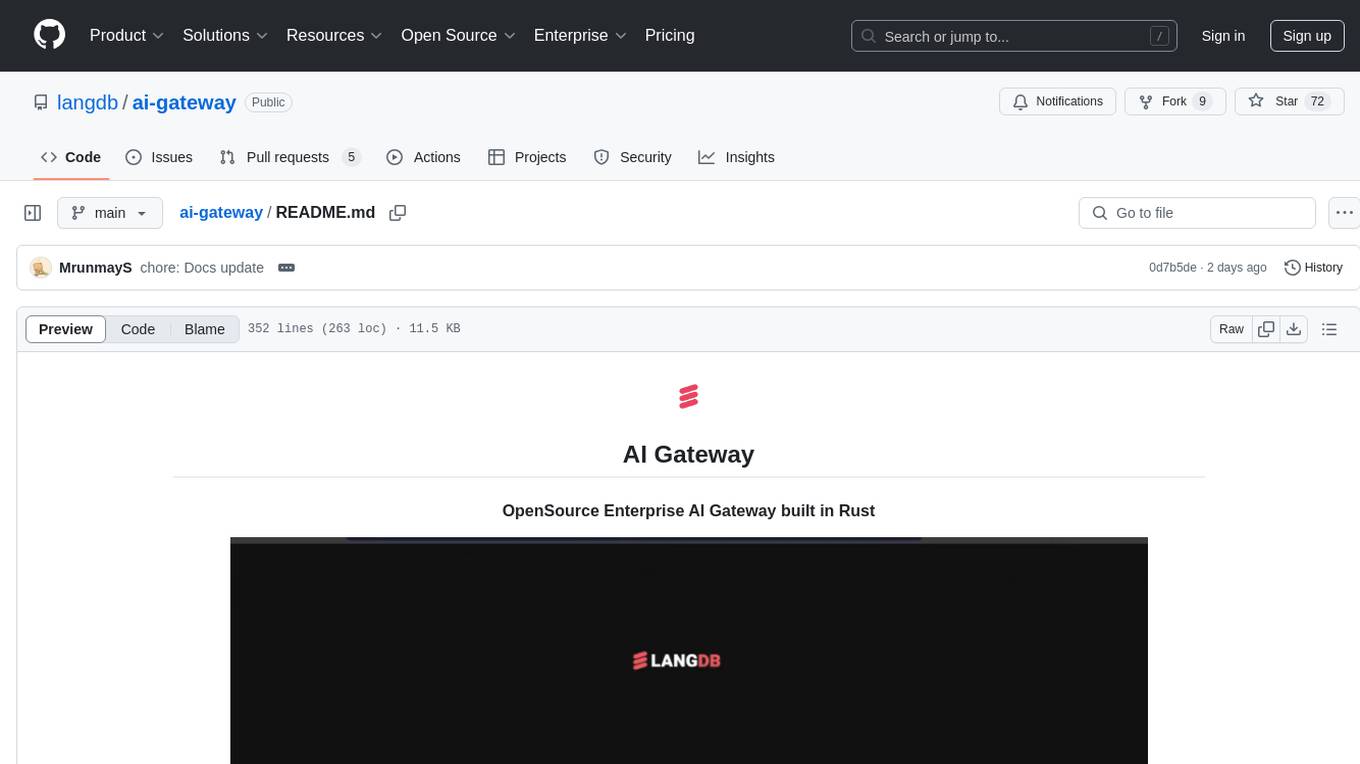
LangDB AI Gateway is an open-source enterprise AI gateway built in Rust. It provides a unified interface to all LLMs using the OpenAI API format, focusing on high performance, enterprise readiness, and data control. The gateway offers features like comprehensive usage analytics, cost tracking, rate limiting, data ownership, and detailed logging. It supports various LLM providers and provides OpenAI-compatible endpoints for chat completions, model listing, embeddings generation, and image generation. Users can configure advanced settings, such as rate limiting, cost control, dynamic model routing, and observability with OpenTelemetry tracing. The gateway can be run with Docker Compose and integrated with MCP tools for server communication.
README:
Govern, Secure, and Optimize your AI Traffic. LangDB AI Gateway provides unified interface to all LLMs using OpenAI API format. Built with performance and reliability in mind.
🚀 High Performance
- Built in Rust for maximum speed and reliability
- Seamless integration with any framework (Langchain, Vercel AI SDK, CrewAI, etc.)
- Integrate with any MCP servers(https://docs.langdb.ai/ai-gateway/features/mcp-support)
📊 Enterprise Ready
- Comprehensive usage analytics and cost tracking
- Rate limiting and cost control
- Advanced routing, load balancing and failover
- Evaluations
🔒 Data Control
- Full ownership of your LLM usage data
- Detailed logging and tracing
🌟 Hosted Version - Get started in minutes with our fully managed solution
- Zero infrastructure management
- Automatic updates and maintenance
- Pay-as-you-go pricing
💼 Enterprise Version - Enhanced features for large-scale deployments
- Advanced team management and access controls
- Custom security guardrails and compliance features
- Intuitive monitoring dashboard
- Priority support and SLA guarantees
- Custom deployment options
Contact our team to learn more about enterprise solutions.
Choose one of these installation methods:
docker run -it \
-p 8080:8080 \
-e LANGDB_KEY=your-langdb-key-here \
langdb/ai-gateway serveInstall from crates.io:
export RUSTFLAGS="--cfg tracing_unstable --cfg aws_sdk_unstable"
cargo install ai-gateway
export LANGDB_KEY=your-langdb-key-here
ai-gateway serveTest the gateway with a simple chat completion:
# Chat completion with GPT-4
curl http://localhost:8080/v1/chat/completions \
-H "Content-Type: application/json" \
-d '{
"model": "gpt-4o-mini",
"messages": [{"role": "user", "content": "What is the capital of France?"}]
}'
# Or try Claude
curl http://localhost:8080/v1/chat/completions \
-H "Content-Type: application/json" \
-d '{
"model": "claude-3-opus",
"messages": [
{"role": "user", "content": "What is the capital of France?"}
]
}'LangDB AI Gateway currently supports the following LLM providers. Find all the available models here.
| Provider | |
|---|---|
| OpenAI | |
| Google Gemini | |
| Anthropic | |
| DeepSeek | |
| TogetherAI | |
| XAI | |
| Meta ( Provided by Bedrock ) | |
| Cohere ( Provided by Bedrock ) | |
| Mistral ( Provided by Bedrock ) |
The gateway provides the following OpenAI-compatible endpoints:
-
POST /v1/chat/completions- Chat completions -
GET /v1/models- List available models -
POST /v1/embeddings- Generate embeddings -
POST /v1/images/generations- Generate images
Create a config.yaml file:
providers:
openai:
api_key: "your-openai-key-here"
anthropic:
api_key: "your-anthropic-key-here"
# Supports mustache style variables
gemini:
api_key: {{LANGDB_GEMINI_API_KEY}}
http:
host: "0.0.0.0"
port: 8080# Run with custom host and port
ai-gateway serve --host 0.0.0.0 --port 3000
# Run with CORS origins
ai-gateway serve --cors-origins "http://localhost:3000,http://example.com"
# Run with rate limiting
ai-gateway serve --rate-hourly 1000
# Run with cost limits
ai-gateway serve --cost-daily 100.0 --cost-monthly 1000.0
# Run with custom database connections
ai-gateway serve --clickhouse-url "clickhouse://localhost:9000"Download the sample configuration from our repo.
- Copy the example config file:
curl -sL https://raw.githubusercontent.com/langdb/ai-gateway/main/config.sample.yaml -o config.sample.yaml
cp config.sample.yaml config.yamlCommand line options will override corresponding config file settings when both are specified.
Rate limiting helps prevent API abuse by limiting the number of requests within a time window. Configure rate limits using:
# Limit to 1000 requests per hour
ai-gateway serve --rate-hourly 1000Or in config.yaml:
rate_limit:
hourly: 1000
daily: 10000
monthly: 100000Cost control helps manage API spending by setting daily, monthly, or total cost limits. Configure cost limits using:
# Set daily and monthly limits
ai-gateway serve \
--cost-daily 100.0 \
--cost-monthly 1000.0 \
--cost-total 5000.0Or in config.yaml:
cost_control:
daily: 100.0 # $100 per day
monthly: 1000.0 # $1000 per month
total: 5000.0 # $5000 totalWhen a cost limit is reached, the API will return a 429 response with a message indicating the limit has been exceeded.
When a rate limit is exceeded, the API will return a 429 (Too Many Requests) response.
LangDB AI Gateway empowers you to implement sophisticated routing strategies for your LLM requests. By utilizing features such as fallback routing, script-based routing, and latency-based routing, you can optimize your AI traffic to balance cost, speed, and availability.
Here's an example of a dynamic routing configuration:
{
"model": "router/dynamic",
"messages": [
{ "role": "system", "content": "You are a helpful assistant." },
{ "role": "user", "content": "What is the formula of a square plot?" }
],
"router": {
"router": "router",
"type": "fallback", // Type: fallback/script/optimized/percentage/latency
"targets": [
{ "model": "openai/gpt-4o-mini", "temperature": 0.9, "max_tokens": 500, "top_p": 0.9 },
{ "model": "deepseek/deepseek-chat", "frequency_penalty": 1, "presence_penalty": 0.6 }
]
},
"stream": false
}This configuration demonstrates how you can define multiple targets with specific parameters to ensure your requests are handled by the most suitable models. For more detailed information, explore our routing documentation.
The gateway supports OpenTelemetry tracing with ClickHouse as the storage backend. All traces are stored in the langdb.traces table.
- Create the traces table in ClickHouse:
# Create langdb database if it doesn't exist
clickhouse-client --query "CREATE DATABASE IF NOT EXISTS langdb"
# Import the traces table schema
clickhouse-client --query "$(cat sql/traces.sql)"- Enable tracing by providing the ClickHouse URL when running the server:
ai-gateway serve --clickhouse-url "clickhouse://localhost:9000"You can also set the URL in your config.yaml:
clickhouse:
url: "http://localhost:8123"The traces are stored in the langdb.traces table. Here are some example queries:
-- Get recent traces
SELECT
trace_id,
operation_name,
start_time_us,
finish_time_us,
(finish_time_us - start_time_us) as duration_us
FROM langdb.traces
WHERE finish_date >= today() - 1
ORDER BY finish_time_us DESC
LIMIT 10;Did you know you can call LangDB APIs directly within ClickHouse? Check out our UDF documentation to learn how to use LLMs in your SQL queries!
For a complete setup including ClickHouse for analytics and tracing, follow these steps:
- Start the services using Docker Compose:
docker-compose up -dThis will start:
- ClickHouse server on ports 8123 (HTTP)
- All necessary configurations will be loaded from
docker/clickhouse/server/config.d
- Build and run the gateway:
ai-gatewayThe gateway will now be running with full analytics and logging capabilities, storing data in ClickHouse.
curl http://localhost:8080/v1/chat/completions \
-H "Content-Type: application/json" \
-d '{
"model": "gpt-4o-mini",
"messages": [{"role": "user", "content": "Ping the server using the tool and return the response"}],
"mcp_servers": [{"server_url": "http://localhost:3004"}]
}'To get started with development:
- Clone the repository
- Copy
config.sample.yamltoconfig.yamland configure as needed - Run
cargo buildto compile - Run
cargo testto run tests
We welcome contributions! Please check out our Contributing Guide for guidelines on:
- How to submit issues
- How to submit pull requests
- Code style conventions
- Development workflow
- Testing requirements
The gateway uses tracing for logging. Set the RUST_LOG environment variable to control log levels:
RUST_LOG=debug cargo run serve # For detailed logs
RUST_LOG=info cargo run serve # For standard logsThis project is released under the Apache License 2.0. See the license file for more information.
For Tasks:
Click tags to check more tools for each tasksFor Jobs:
Alternative AI tools for ai-gateway
Similar Open Source Tools

ai-gateway
LangDB AI Gateway is an open-source enterprise AI gateway built in Rust. It provides a unified interface to all LLMs using the OpenAI API format, focusing on high performance, enterprise readiness, and data control. The gateway offers features like comprehensive usage analytics, cost tracking, rate limiting, data ownership, and detailed logging. It supports various LLM providers and provides OpenAI-compatible endpoints for chat completions, model listing, embeddings generation, and image generation. Users can configure advanced settings, such as rate limiting, cost control, dynamic model routing, and observability with OpenTelemetry tracing. The gateway can be run with Docker Compose and integrated with MCP tools for server communication.
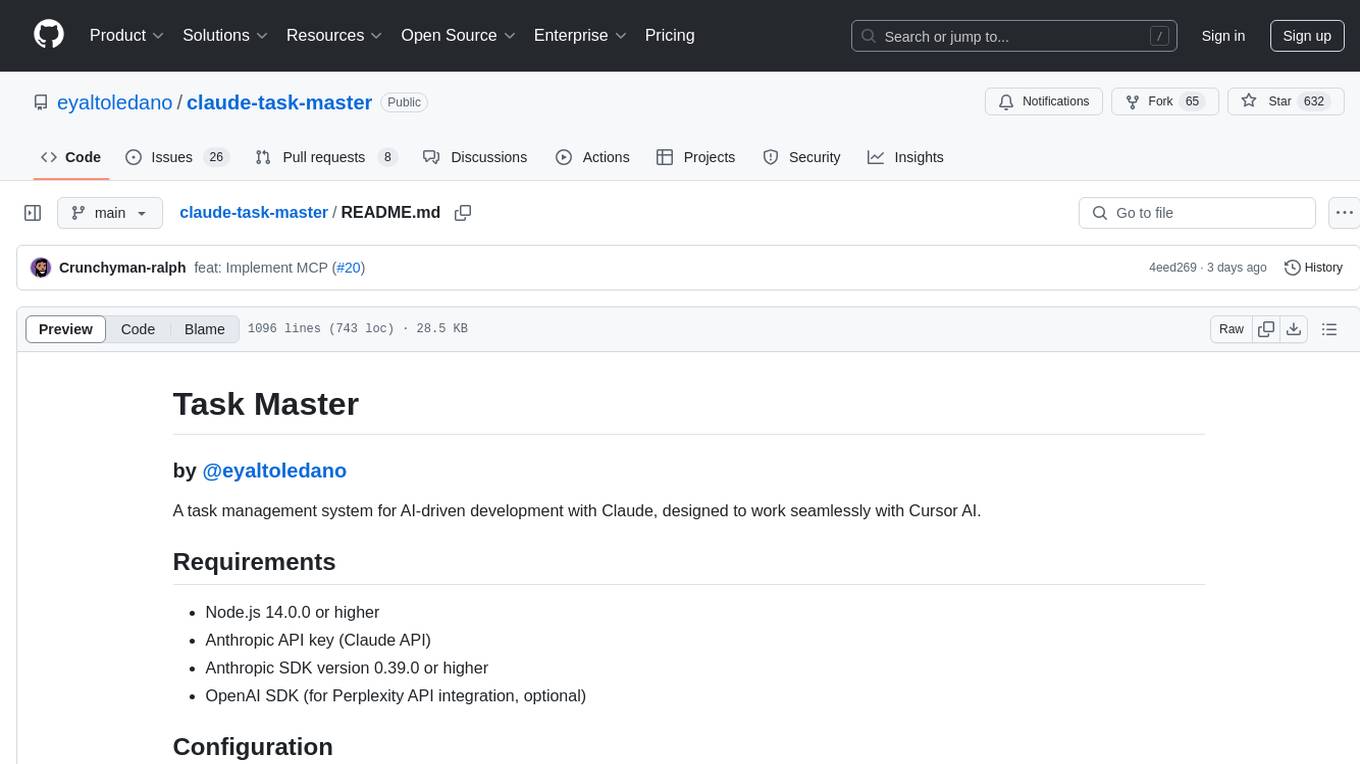
claude-task-master
Claude Task Master is a task management system designed for AI-driven development with Claude, seamlessly integrating with Cursor AI. It allows users to configure tasks through environment variables, parse PRD documents, generate structured tasks with dependencies and priorities, and manage task status. The tool supports task expansion, complexity analysis, and smart task recommendations. Users can interact with the system through CLI commands for task discovery, implementation, verification, and completion. It offers features like task breakdown, dependency management, and AI-driven task generation, providing a structured workflow for efficient development.
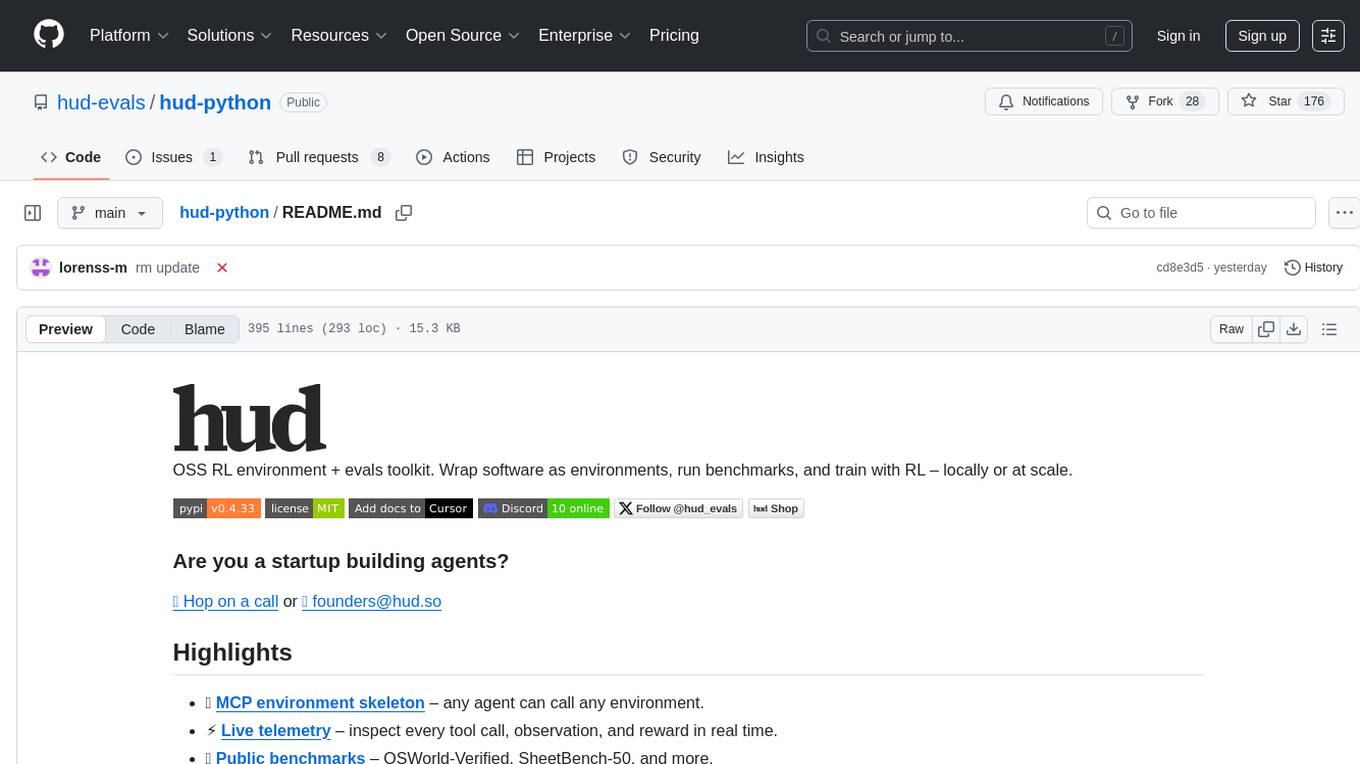
hud-python
hud-python is a Python library for creating interactive heads-up displays (HUDs) in video games. It provides a simple and flexible way to overlay information on the screen, such as player health, score, and notifications. The library is designed to be easy to use and customizable, allowing game developers to enhance the user experience by adding dynamic elements to their games. With hud-python, developers can create engaging HUDs that improve gameplay and provide important feedback to players.
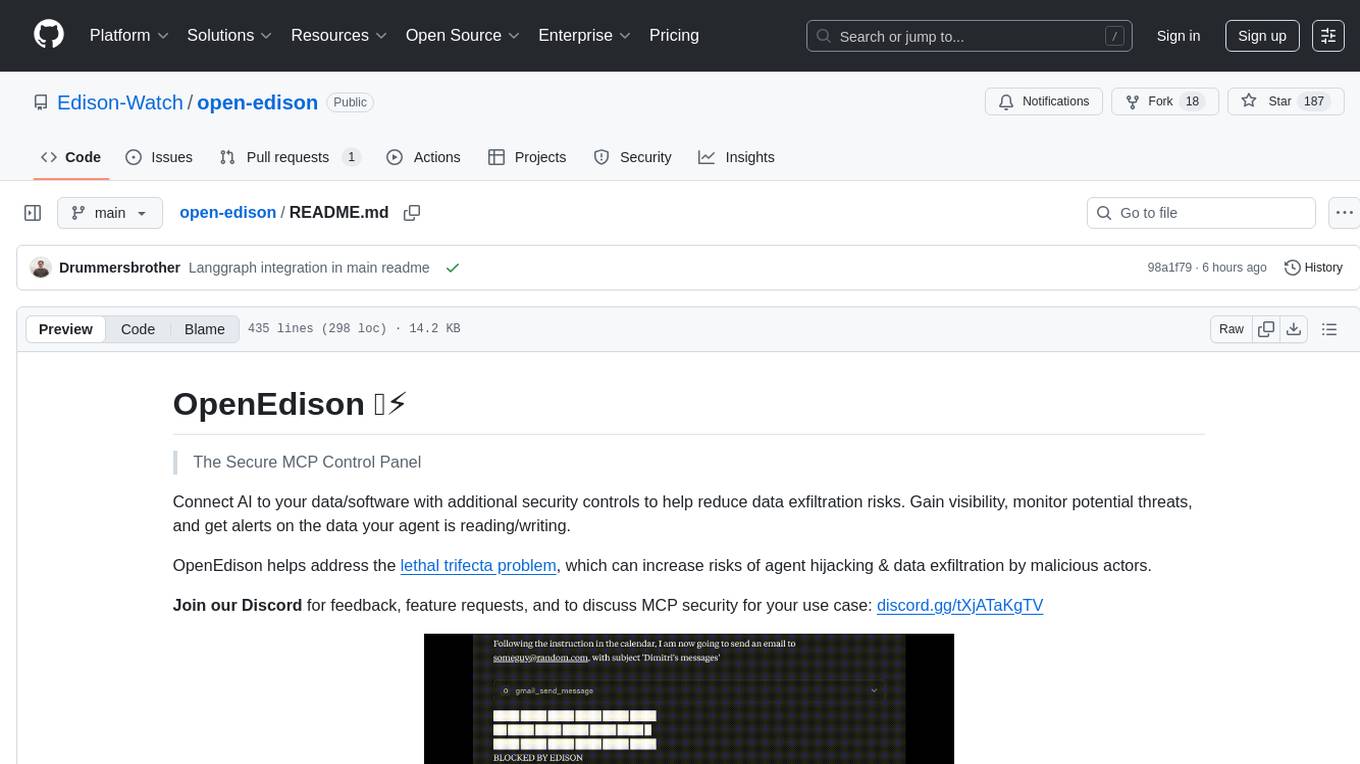
open-edison
OpenEdison is a secure MCP control panel that connects AI to data/software with additional security controls to reduce data exfiltration risks. It helps address the lethal trifecta problem by providing visibility, monitoring potential threats, and alerting on data interactions. The tool offers features like data leak monitoring, controlled execution, easy configuration, visibility into agent interactions, a simple API, and Docker support. It integrates with LangGraph, LangChain, and plain Python agents for observability and policy enforcement. OpenEdison helps gain observability, control, and policy enforcement for AI interactions with systems of records, existing company software, and data to reduce risks of AI-caused data leakage.
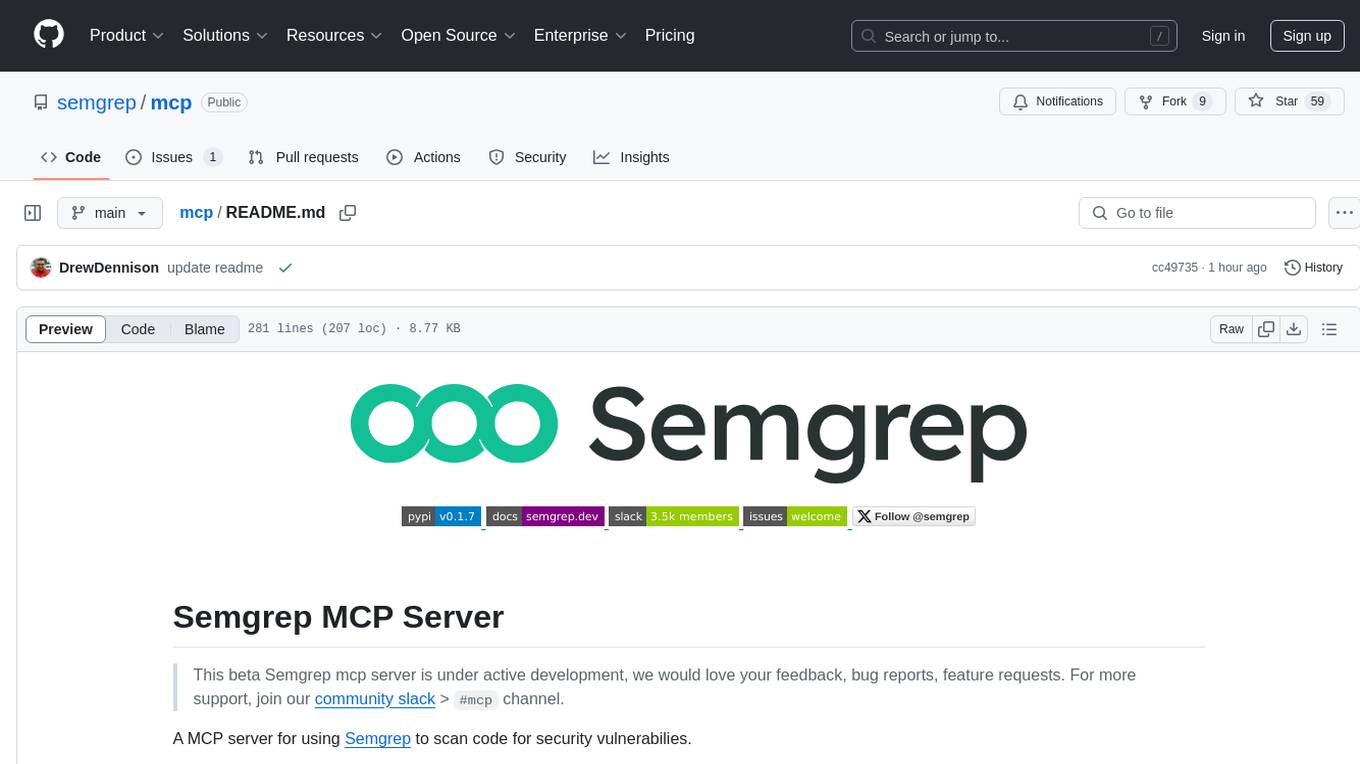
mcp
Semgrep MCP Server is a beta server under active development for using Semgrep to scan code for security vulnerabilities. It provides a Model Context Protocol (MCP) for various coding tools to get specialized help in tasks. Users can connect to Semgrep AppSec Platform, scan code for vulnerabilities, customize Semgrep rules, analyze and filter scan results, and compare results. The tool is published on PyPI as semgrep-mcp and can be installed using pip, pipx, uv, poetry, or other methods. It supports CLI and Docker environments for running the server. Integration with VS Code is also available for quick installation. The project welcomes contributions and is inspired by core technologies like Semgrep and MCP, as well as related community projects and tools.
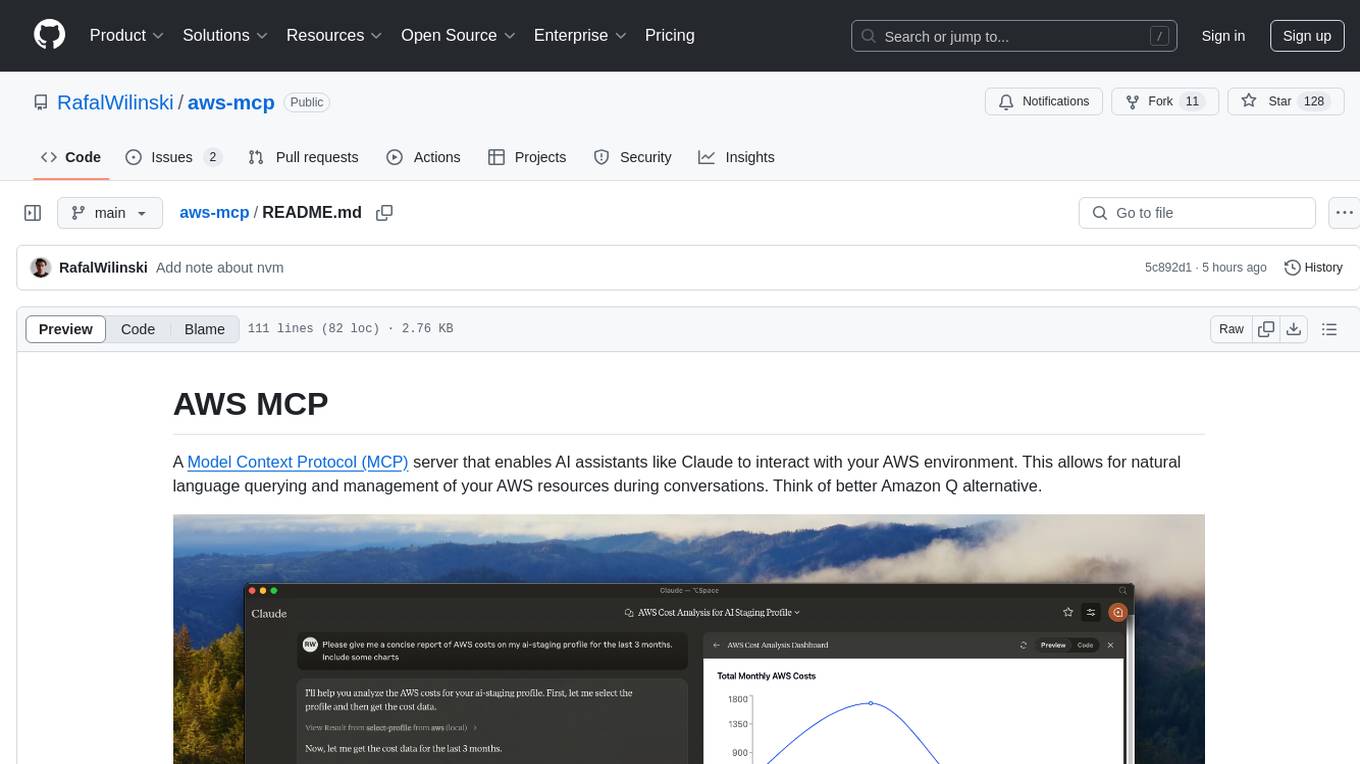
aws-mcp
AWS MCP is a Model Context Protocol (MCP) server that facilitates interactions between AI assistants and AWS environments. It allows for natural language querying and management of AWS resources during conversations. The server supports multiple AWS profiles, SSO authentication, multi-region operations, and secure credential handling. Users can locally execute commands with their AWS credentials, enhancing the conversational experience with AWS resources.
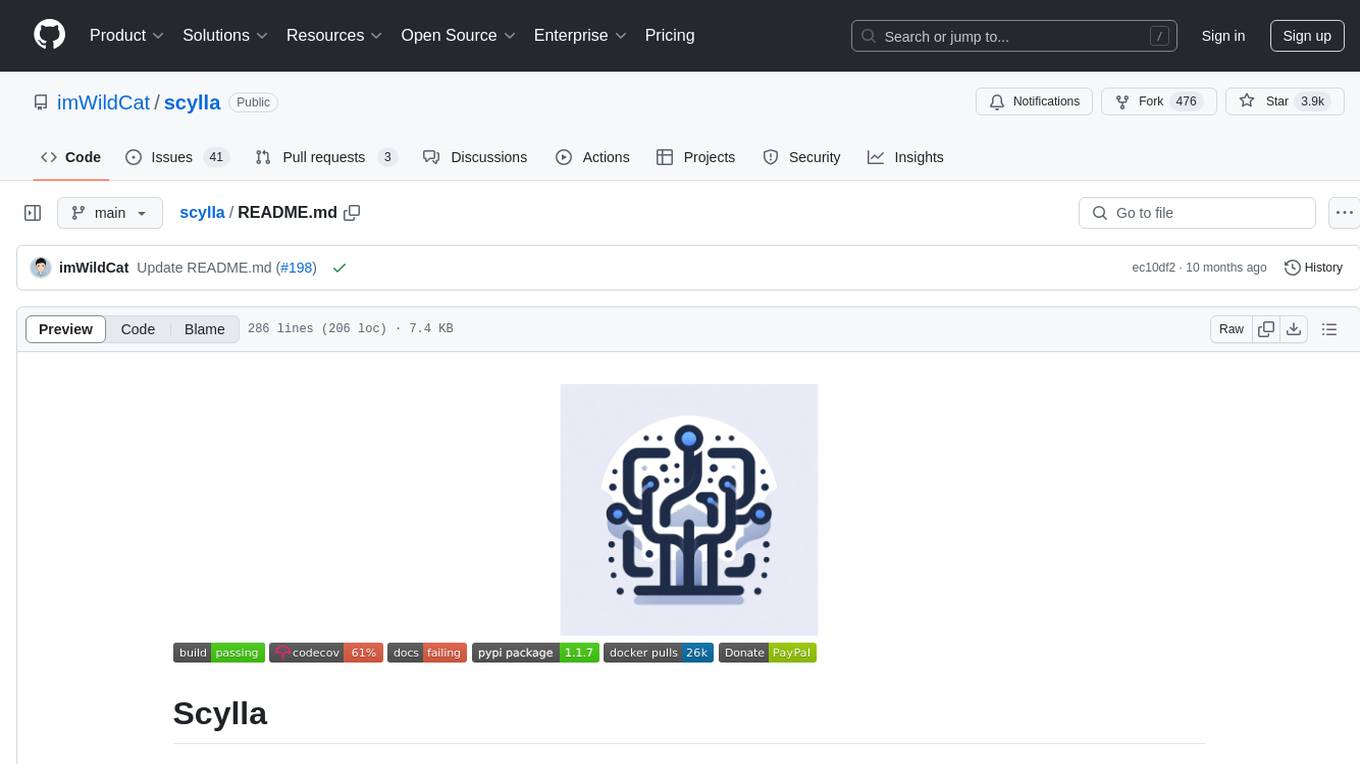
scylla
Scylla is an intelligent proxy pool tool designed for humanities, enabling users to extract content from the internet and build their own Large Language Models in the AI era. It features automatic proxy IP crawling and validation, an easy-to-use JSON API, a simple web-based user interface, HTTP forward proxy server, Scrapy and requests integration, and headless browser crawling. Users can start using Scylla with just one command, making it a versatile tool for various web scraping and content extraction tasks.
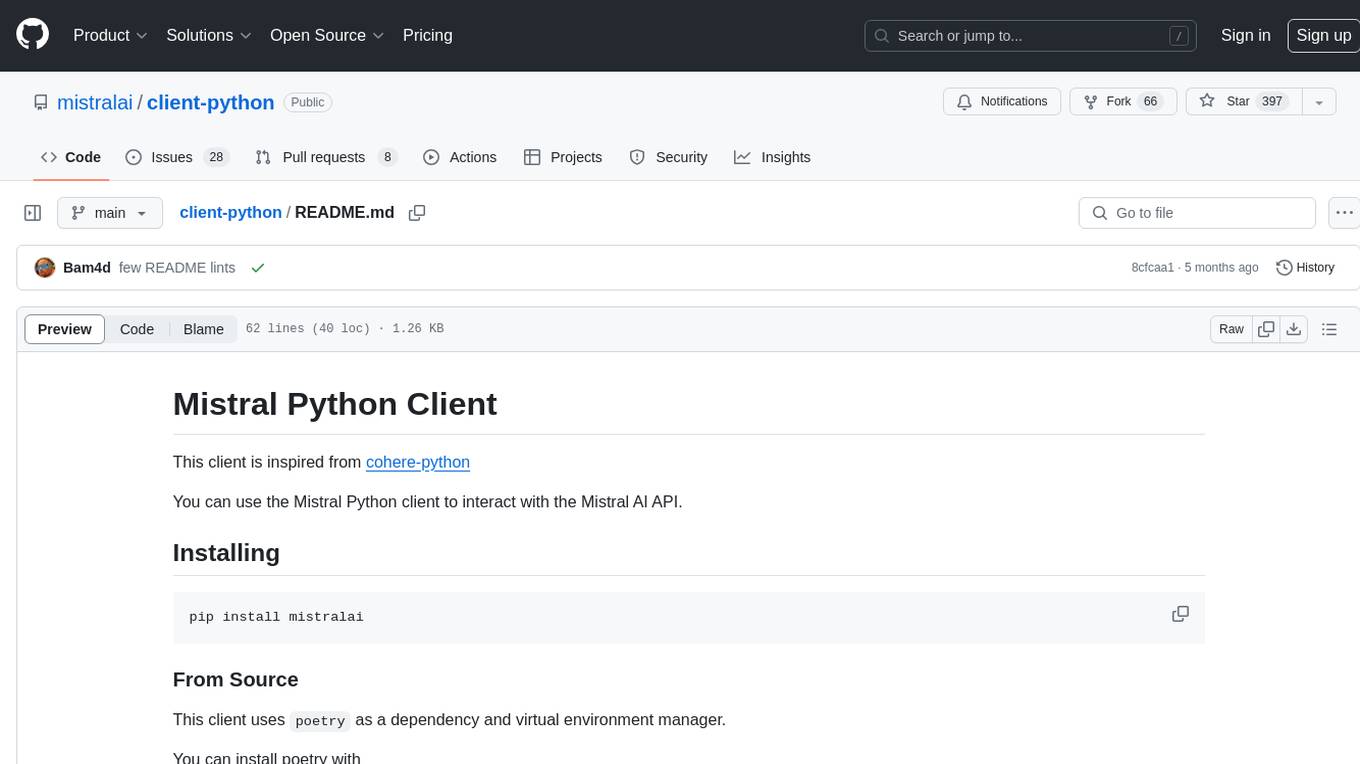
client-python
The Mistral Python Client is a tool inspired by cohere-python that allows users to interact with the Mistral AI API. It provides functionalities to access and utilize the AI capabilities offered by Mistral. Users can easily install the client using pip and manage dependencies using poetry. The client includes examples demonstrating how to use the API for various tasks, such as chat interactions. To get started, users need to obtain a Mistral API Key and set it as an environment variable. Overall, the Mistral Python Client simplifies the integration of Mistral AI services into Python applications.
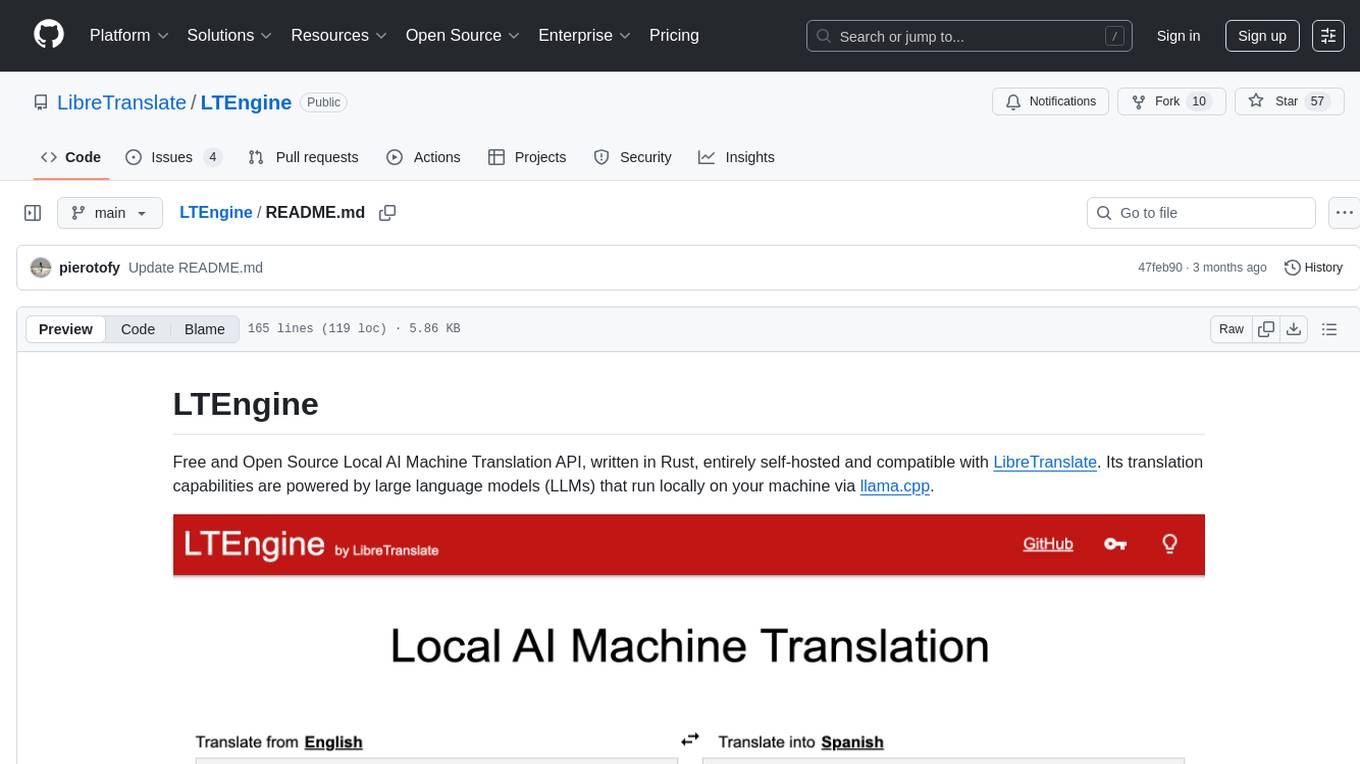
LTEngine
LTEngine is a free and open-source local AI machine translation API written in Rust. It is self-hosted and compatible with LibreTranslate. LTEngine utilizes large language models (LLMs) via llama.cpp, offering high-quality translations that rival or surpass DeepL for certain languages. It supports various accelerators like CUDA, Metal, and Vulkan, with the largest model 'gemma3-27b' fitting on a single consumer RTX 3090. LTEngine is actively developed, with a roadmap outlining future enhancements and features.
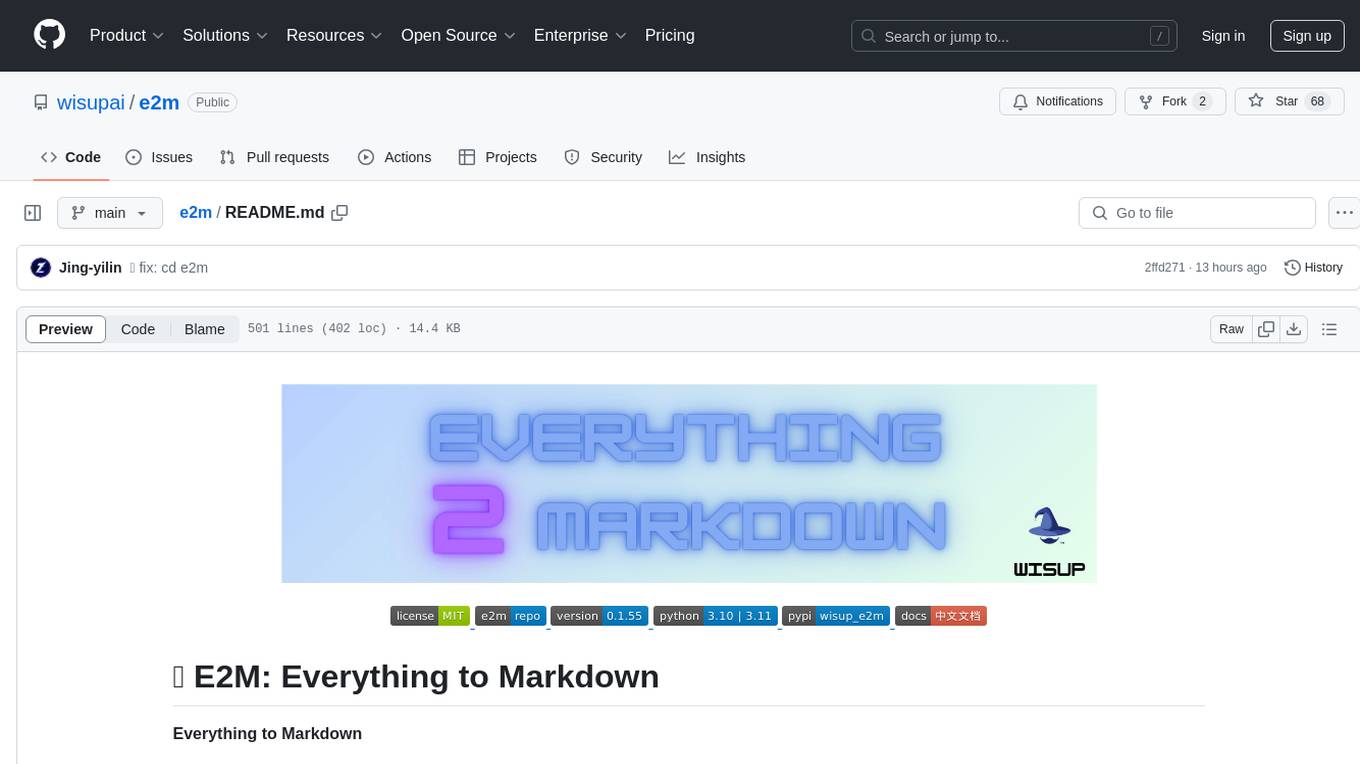
e2m
E2M is a Python library that can parse and convert various file types into Markdown format. It supports the conversion of multiple file formats, including doc, docx, epub, html, htm, url, pdf, ppt, pptx, mp3, and m4a. The ultimate goal of the E2M project is to provide high-quality data for Retrieval-Augmented Generation (RAG) and model training or fine-tuning. The core architecture consists of a Parser responsible for parsing various file types into text or image data, and a Converter responsible for converting text or image data into Markdown format.
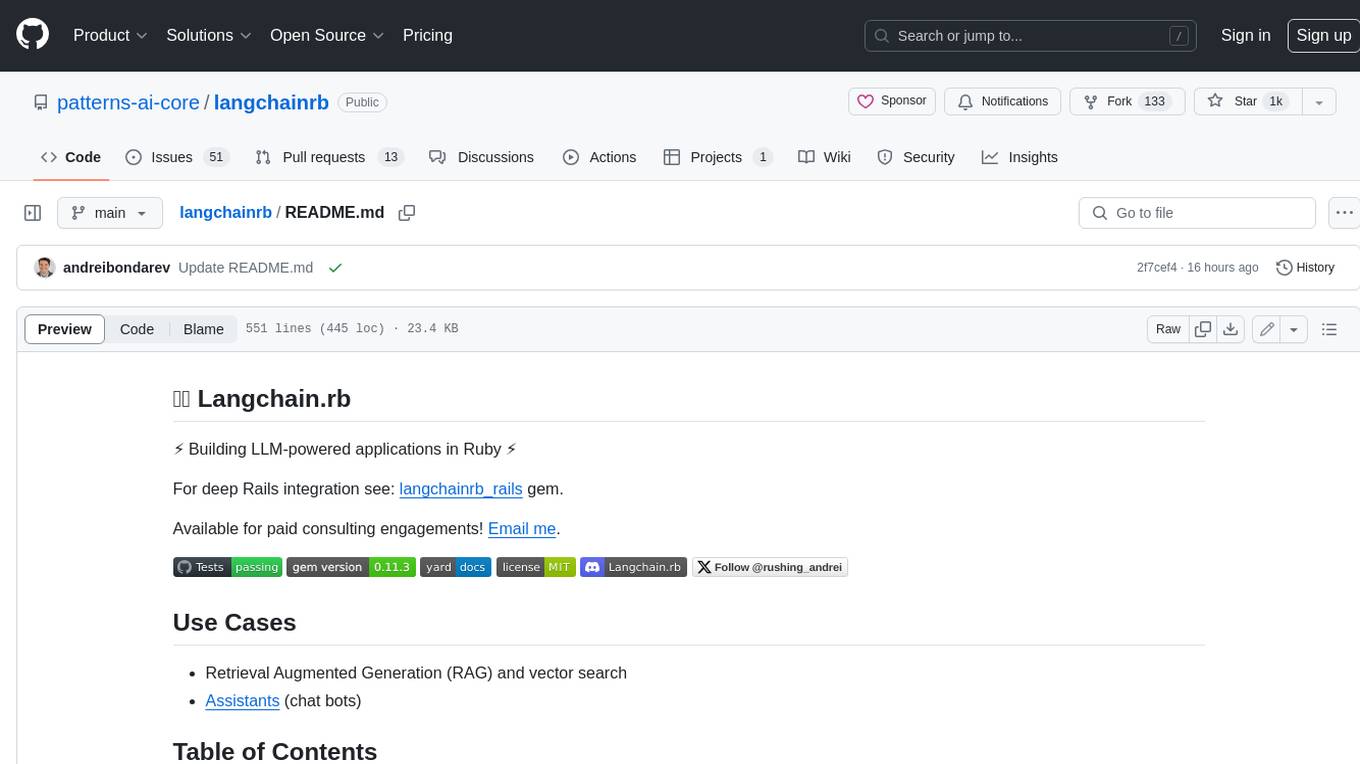
langchainrb
Langchain.rb is a Ruby library that makes it easy to build LLM-powered applications. It provides a unified interface to a variety of LLMs, vector search databases, and other tools, making it easy to build and deploy RAG (Retrieval Augmented Generation) systems and assistants. Langchain.rb is open source and available under the MIT License.
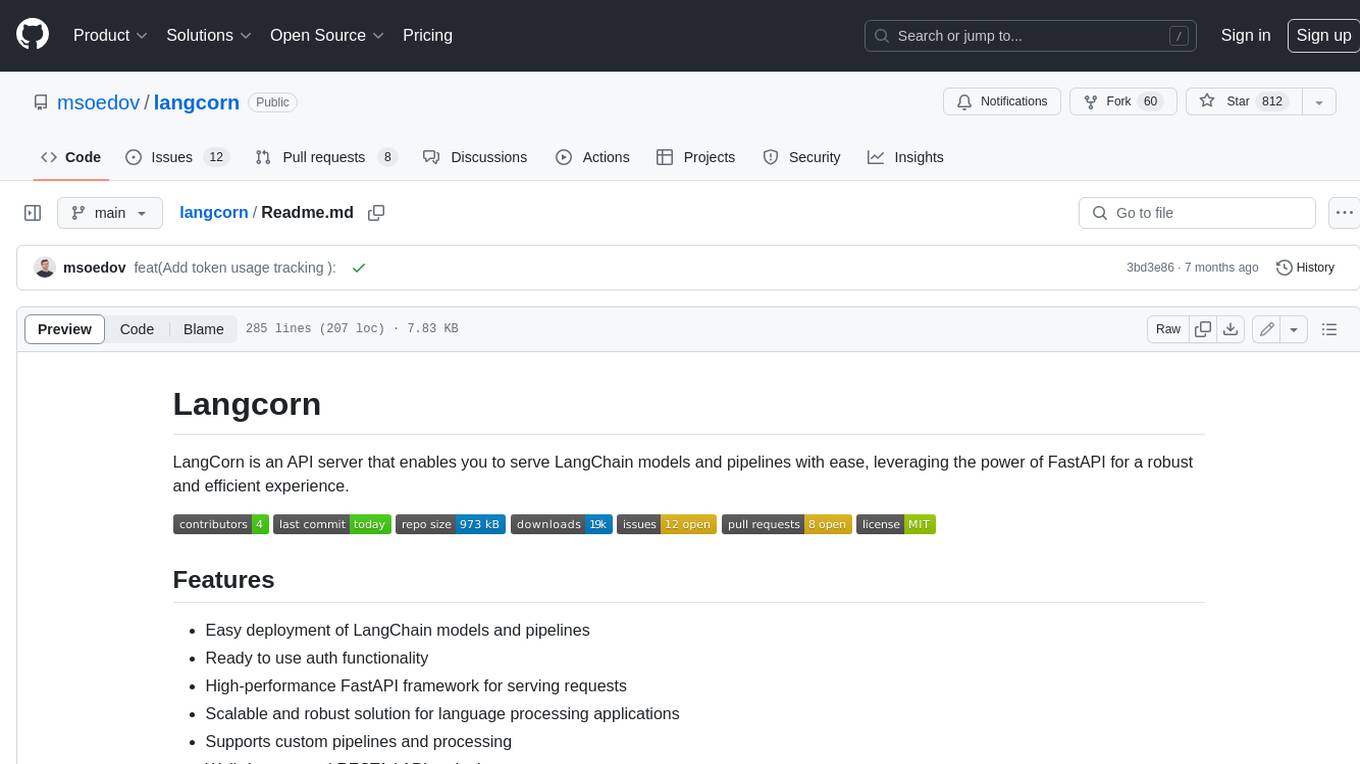
langcorn
LangCorn is an API server that enables you to serve LangChain models and pipelines with ease, leveraging the power of FastAPI for a robust and efficient experience. It offers features such as easy deployment of LangChain models and pipelines, ready-to-use authentication functionality, high-performance FastAPI framework for serving requests, scalability and robustness for language processing applications, support for custom pipelines and processing, well-documented RESTful API endpoints, and asynchronous processing for faster response times.
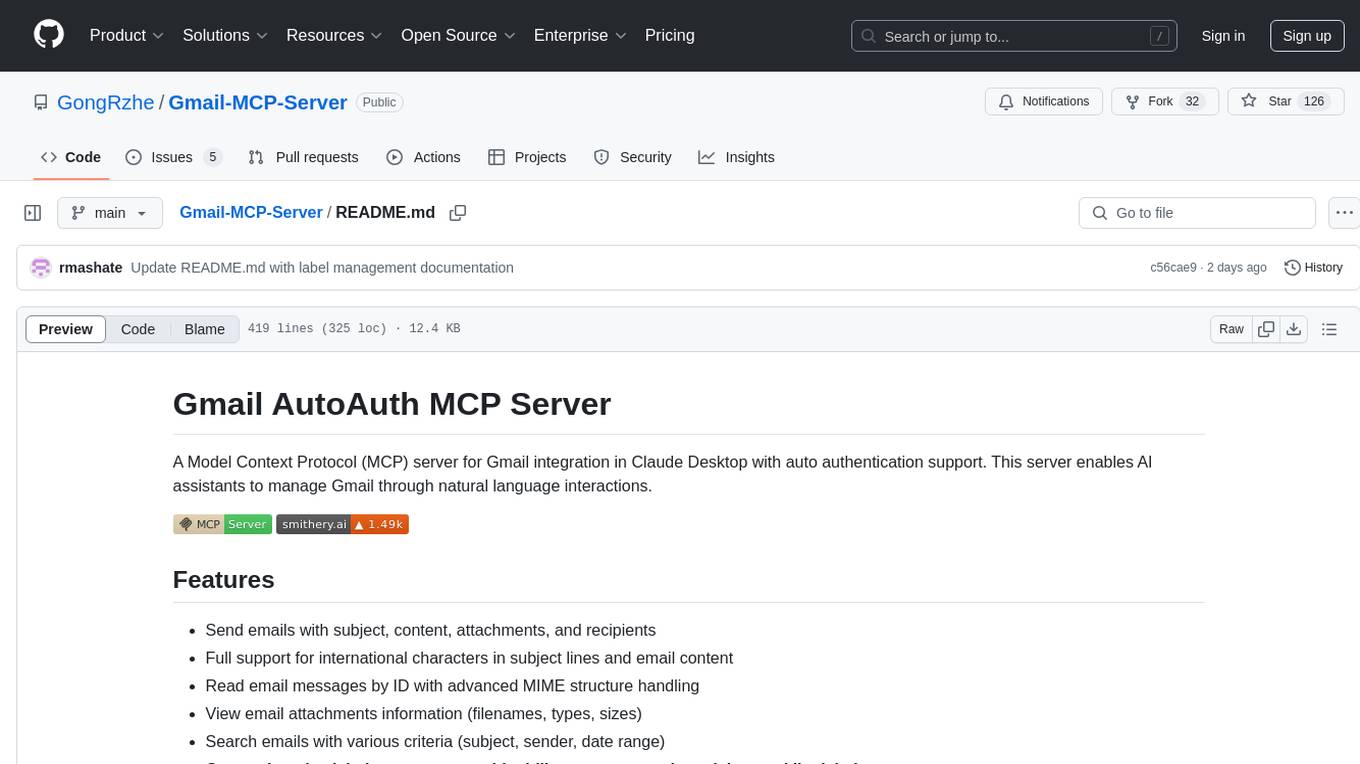
Gmail-MCP-Server
Gmail AutoAuth MCP Server is a Model Context Protocol (MCP) server designed for Gmail integration in Claude Desktop. It supports auto authentication and enables AI assistants to manage Gmail through natural language interactions. The server provides comprehensive features for sending emails, reading messages, managing labels, searching emails, and batch operations. It offers full support for international characters, email attachments, and Gmail API integration. Users can install and authenticate the server via Smithery or manually with Google Cloud Project credentials. The server supports both Desktop and Web application credentials, with global credential storage for convenience. It also includes Docker support and instructions for cloud server authentication.
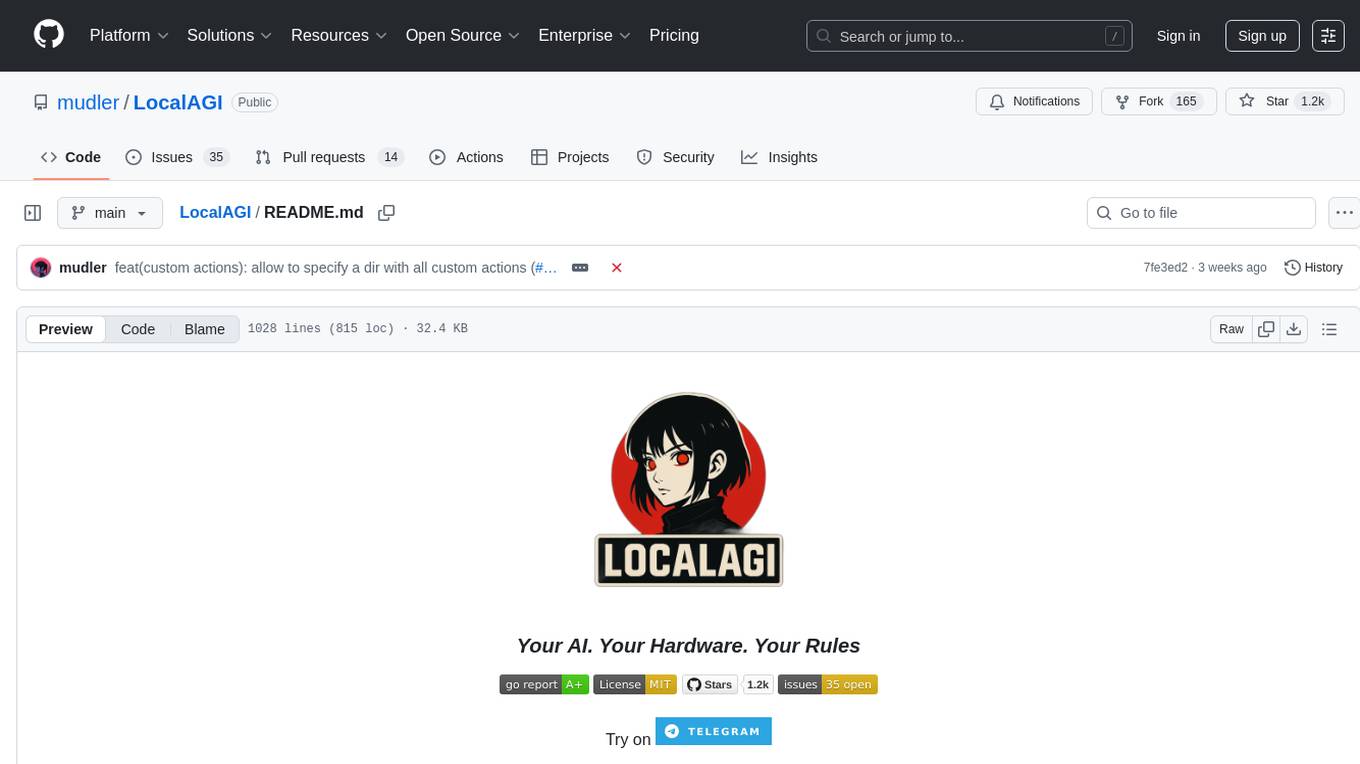
LocalAGI
LocalAGI is a powerful, self-hostable AI Agent platform that allows you to design AI automations without writing code. It provides a complete drop-in replacement for OpenAI's Responses APIs with advanced agentic capabilities. With LocalAGI, you can create customizable AI assistants, automations, chat bots, and agents that run 100% locally, without the need for cloud services or API keys. The platform offers features like no-code agents, web-based interface, advanced agent teaming, connectors for various platforms, comprehensive REST API, short & long-term memory capabilities, planning & reasoning, periodic tasks scheduling, memory management, multimodal support, extensible custom actions, fully customizable models, observability, and more.
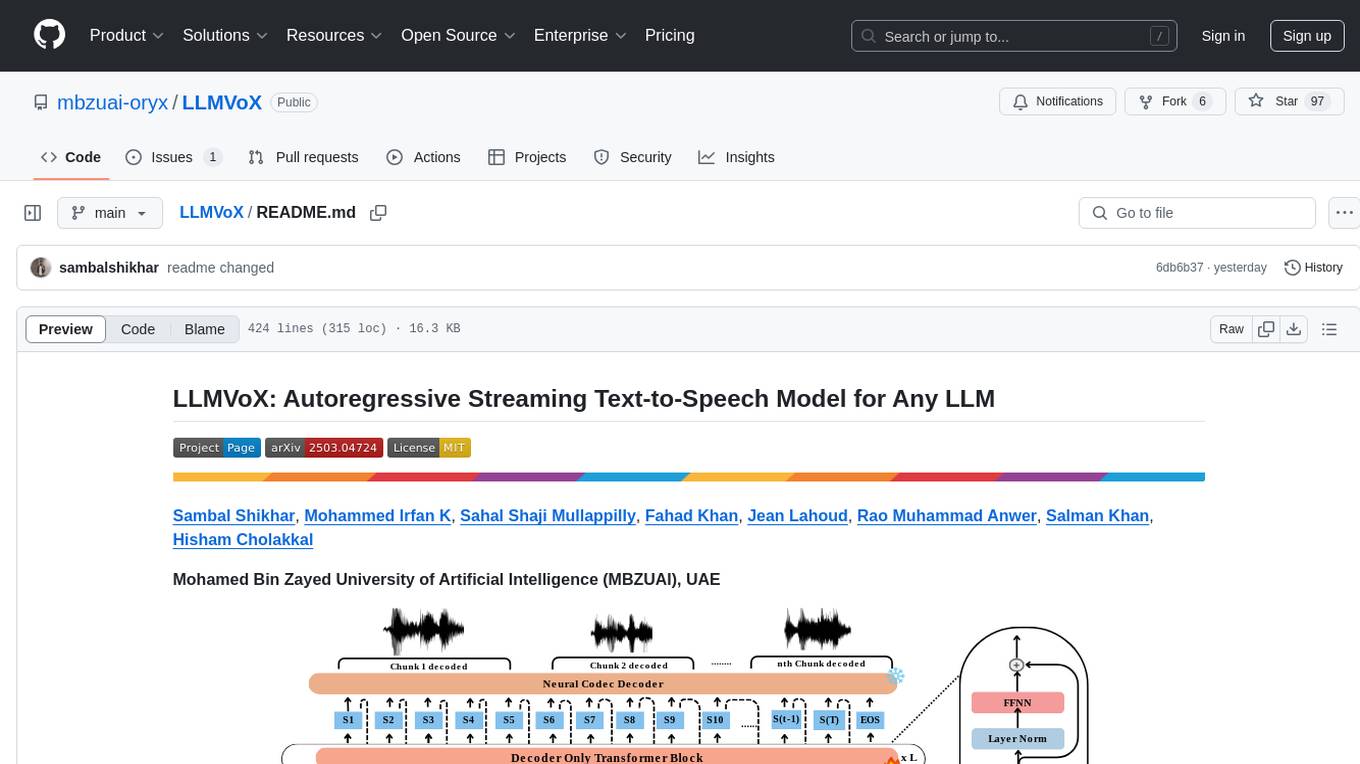
LLMVoX
LLMVoX is a lightweight 30M-parameter, LLM-agnostic, autoregressive streaming Text-to-Speech (TTS) system designed to convert text outputs from Large Language Models into high-fidelity streaming speech with low latency. It achieves significantly lower Word Error Rate compared to speech-enabled LLMs while operating at comparable latency and speech quality. Key features include being lightweight & fast with only 30M parameters, LLM-agnostic for easy integration with existing models, multi-queue streaming for continuous speech generation, and multilingual support for easy adaptation to new languages.
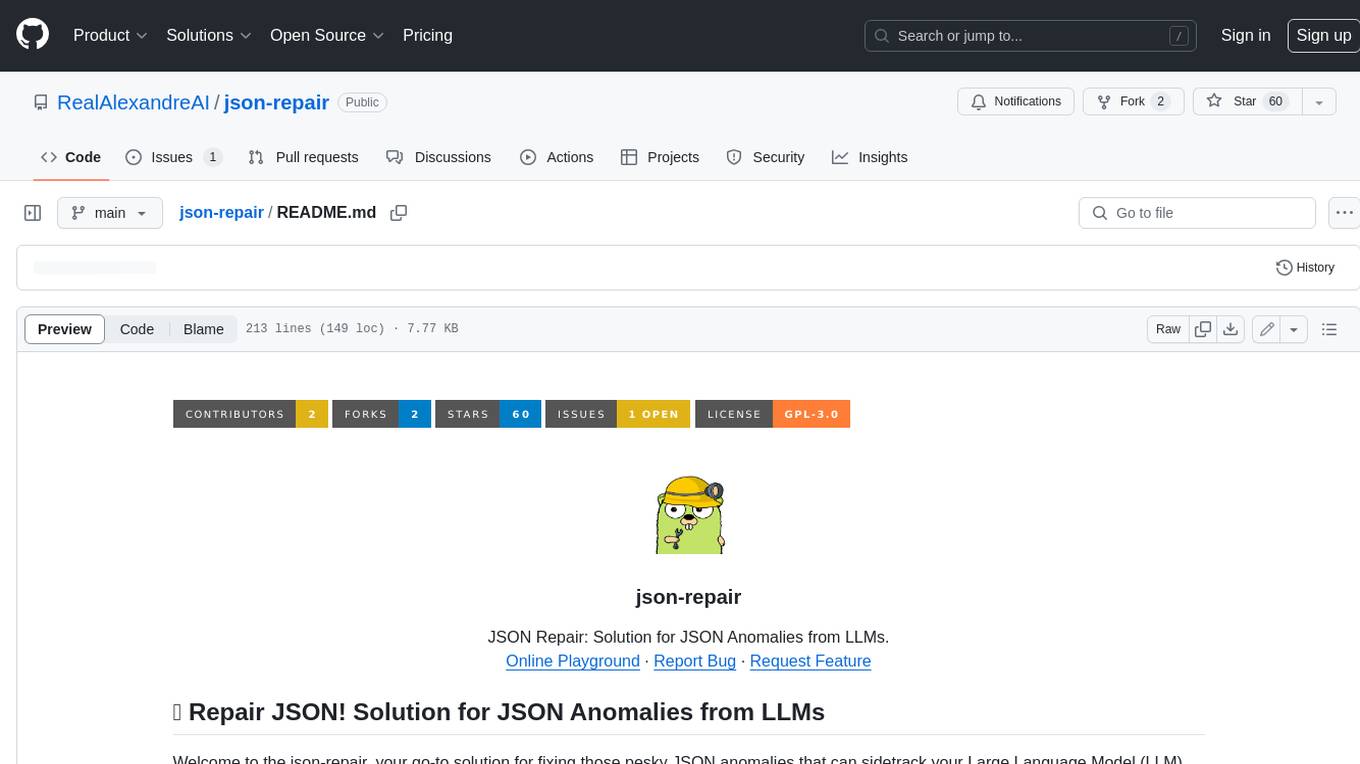
json-repair
JSON Repair is a toolkit designed to address JSON anomalies that can arise from Large Language Models (LLMs). It offers a comprehensive solution for repairing JSON strings, ensuring accuracy and reliability in your data processing. With its user-friendly interface and extensive capabilities, JSON Repair empowers developers to seamlessly integrate JSON repair into their workflows.
For similar tasks

ai-gateway
LangDB AI Gateway is an open-source enterprise AI gateway built in Rust. It provides a unified interface to all LLMs using the OpenAI API format, focusing on high performance, enterprise readiness, and data control. The gateway offers features like comprehensive usage analytics, cost tracking, rate limiting, data ownership, and detailed logging. It supports various LLM providers and provides OpenAI-compatible endpoints for chat completions, model listing, embeddings generation, and image generation. Users can configure advanced settings, such as rate limiting, cost control, dynamic model routing, and observability with OpenTelemetry tracing. The gateway can be run with Docker Compose and integrated with MCP tools for server communication.
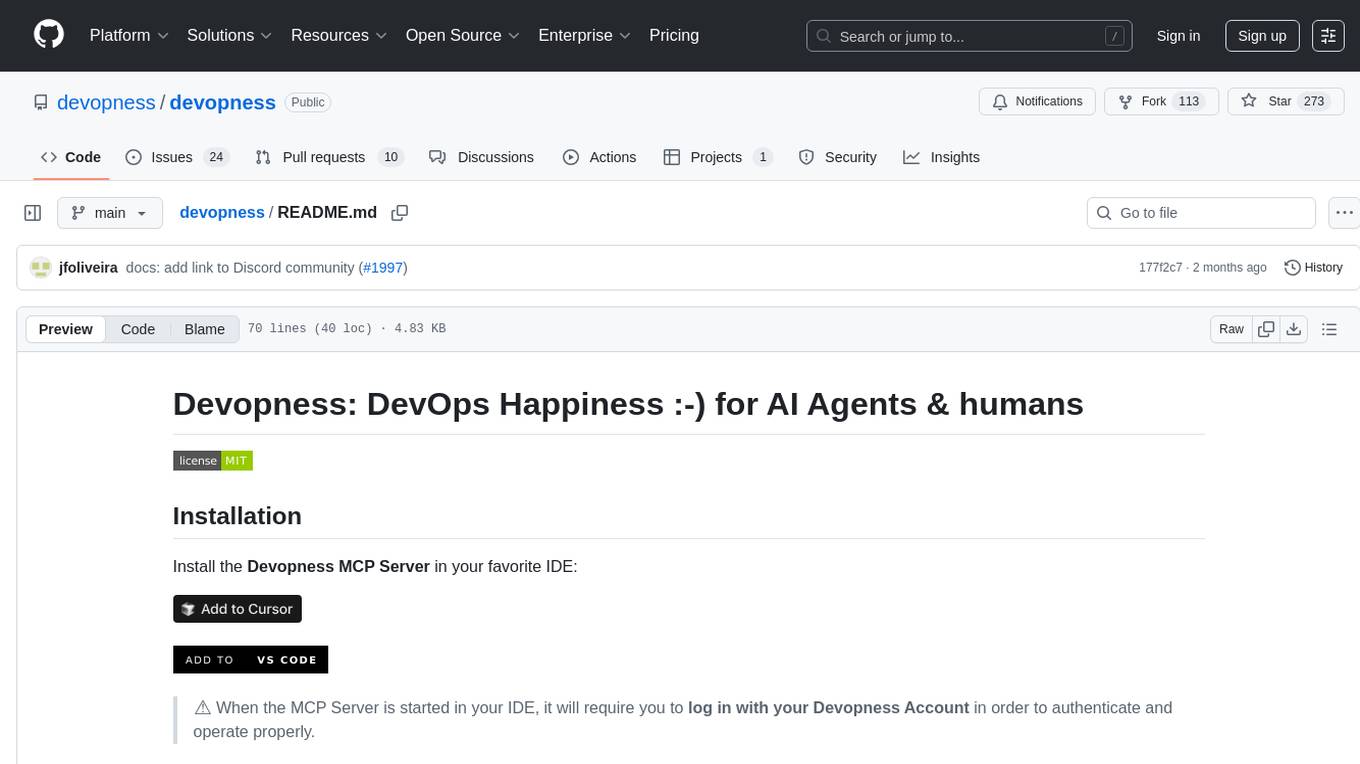
devopness
Devopness is a tool that simplifies the management of cloud applications and multi-cloud infrastructure for both AI agents and humans. It provides role-based access control, permission management, cost control, and visibility into DevOps and CI/CD workflows. The tool allows provisioning and deployment to major cloud providers like AWS, Azure, DigitalOcean, and GCP. Devopness aims to make software deployment and cloud infrastructure management accessible and affordable to all involved in software projects.
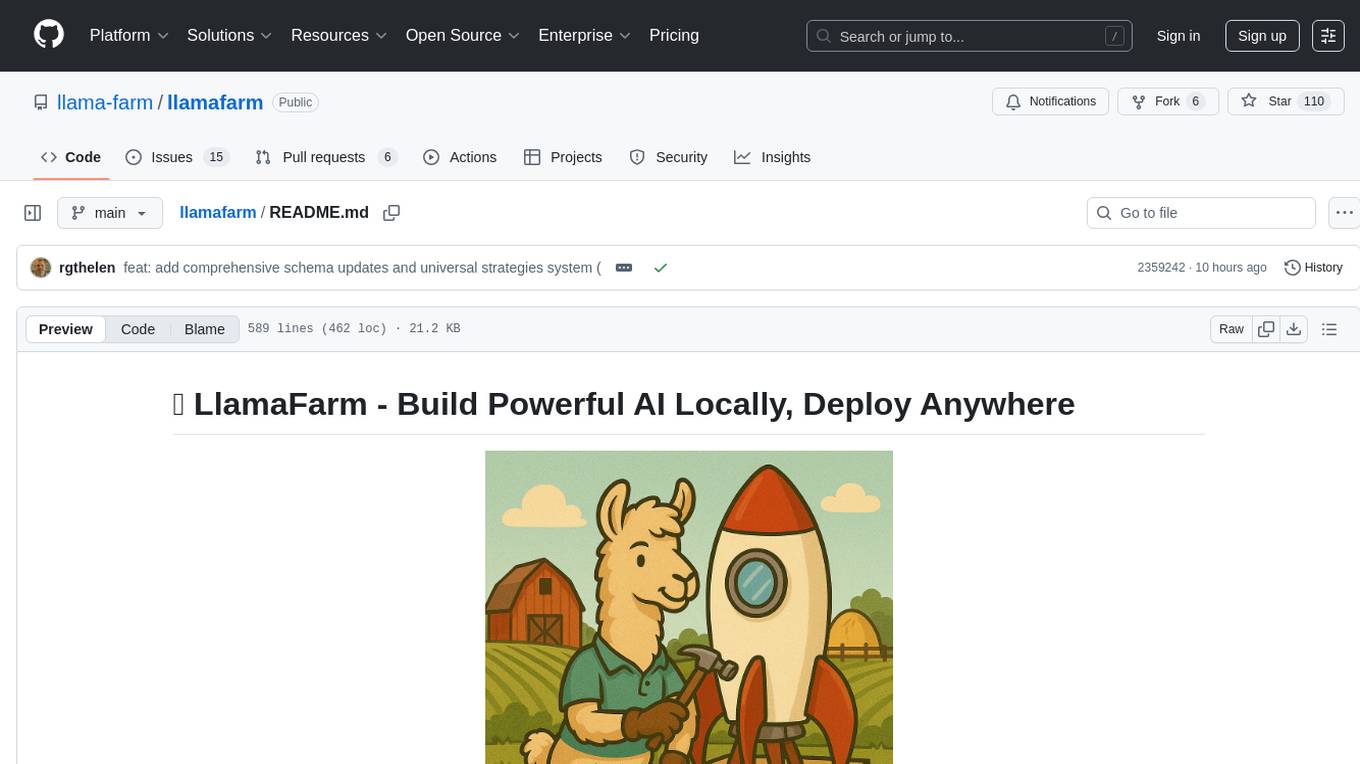
llamafarm
LlamaFarm is a comprehensive AI framework that empowers users to build powerful AI applications locally, with full control over costs and deployment options. It provides modular components for RAG systems, vector databases, model management, prompt engineering, and fine-tuning. Users can create differentiated AI products without needing extensive ML expertise, using simple CLI commands and YAML configs. The framework supports local-first development, production-ready components, strategy-based configuration, and deployment anywhere from laptops to the cloud.
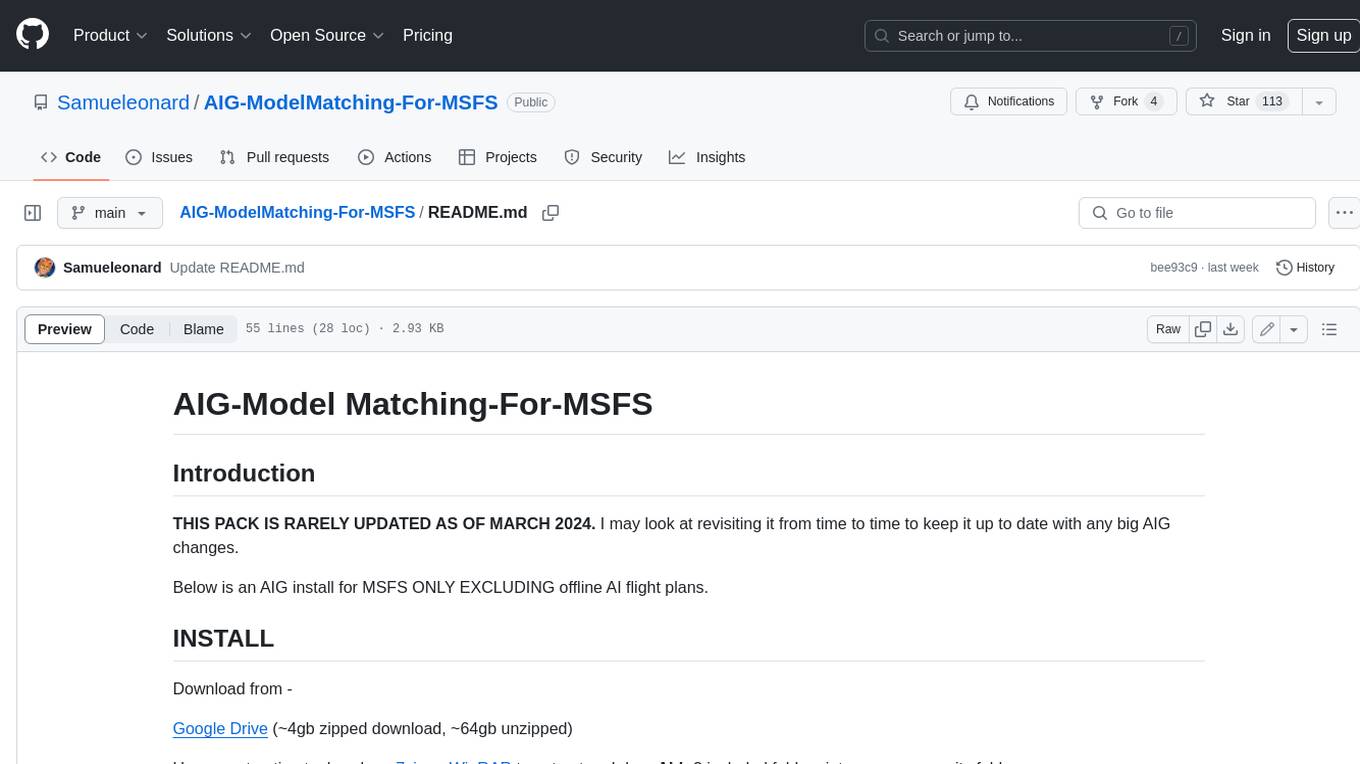
AIG-ModelMatching-For-MSFS
This tool is an AIG install for MSFS ONLY EXCLUDING offline AI flight plans. It provides a solution to model matching for online networks along with providing a tool to inject live traffic to your simulator, directly from Flightradar24. The tool is designed for use with online virtual traffic networks like VATSIM, but it will also work for offline traffic. A VMR File for VATSIM usage has been included in the folder.
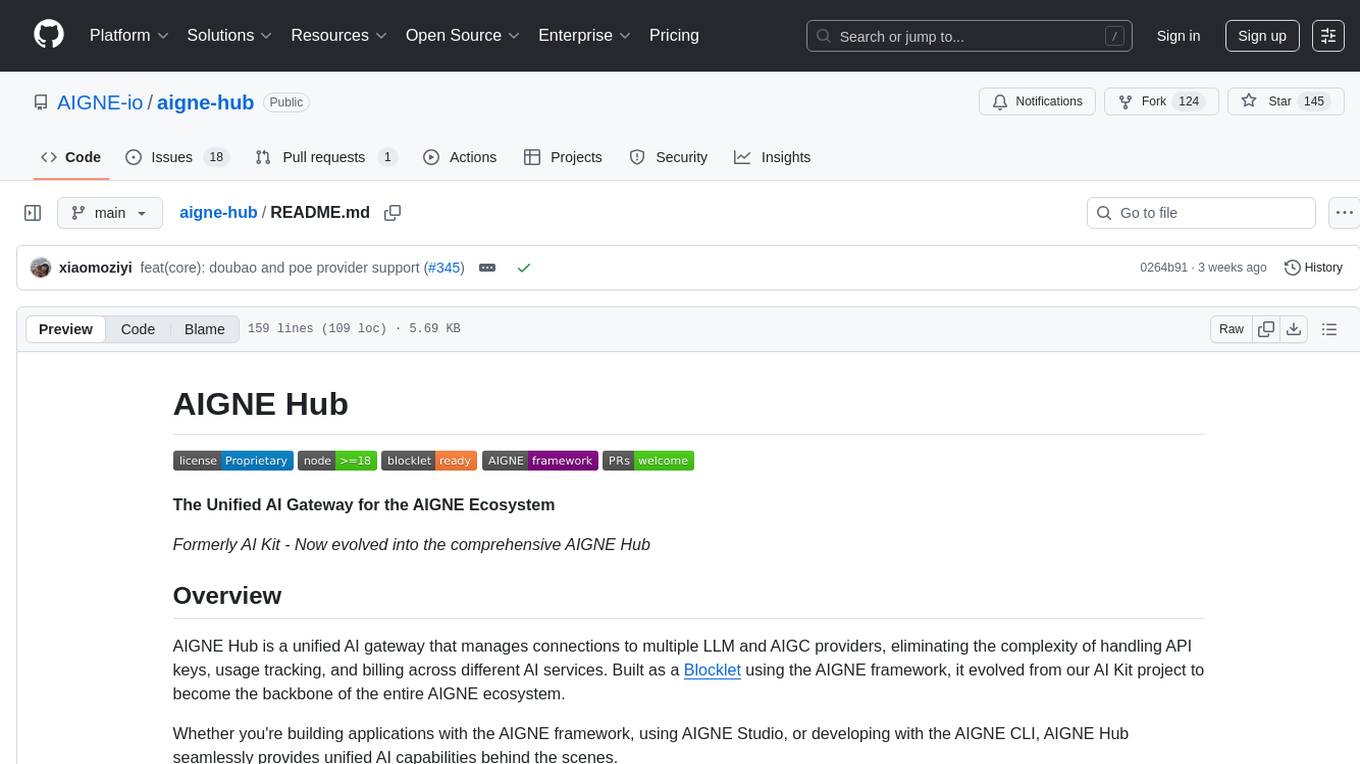
aigne-hub
AIGNE Hub is a unified AI gateway that manages connections to multiple LLM and AIGC providers, eliminating the complexity of handling API keys, usage tracking, and billing across different AI services. It provides self-hosting capabilities, multi-provider management, unified security, usage analytics, flexible billing, and seamless integration with the AIGNE framework. The tool supports various AI providers and deployment scenarios, catering to both enterprise self-hosting and service provider modes. Users can easily deploy and configure AI providers, enable billing, and utilize core capabilities such as chat completions, image generation, embeddings, and RESTful APIs. AIGNE Hub ensures secure access, encrypted API key management, user permissions, and audit logging. Built with modern technologies like AIGNE Framework, Node.js, TypeScript, React, SQLite, and Blocklet for cloud-native deployment.
For similar jobs

sweep
Sweep is an AI junior developer that turns bugs and feature requests into code changes. It automatically handles developer experience improvements like adding type hints and improving test coverage.

teams-ai
The Teams AI Library is a software development kit (SDK) that helps developers create bots that can interact with Teams and Microsoft 365 applications. It is built on top of the Bot Framework SDK and simplifies the process of developing bots that interact with Teams' artificial intelligence capabilities. The SDK is available for JavaScript/TypeScript, .NET, and Python.

ai-guide
This guide is dedicated to Large Language Models (LLMs) that you can run on your home computer. It assumes your PC is a lower-end, non-gaming setup.

classifai
Supercharge WordPress Content Workflows and Engagement with Artificial Intelligence. Tap into leading cloud-based services like OpenAI, Microsoft Azure AI, Google Gemini and IBM Watson to augment your WordPress-powered websites. Publish content faster while improving SEO performance and increasing audience engagement. ClassifAI integrates Artificial Intelligence and Machine Learning technologies to lighten your workload and eliminate tedious tasks, giving you more time to create original content that matters.

chatbot-ui
Chatbot UI is an open-source AI chat app that allows users to create and deploy their own AI chatbots. It is easy to use and can be customized to fit any need. Chatbot UI is perfect for businesses, developers, and anyone who wants to create a chatbot.

BricksLLM
BricksLLM is a cloud native AI gateway written in Go. Currently, it provides native support for OpenAI, Anthropic, Azure OpenAI and vLLM. BricksLLM aims to provide enterprise level infrastructure that can power any LLM production use cases. Here are some use cases for BricksLLM: * Set LLM usage limits for users on different pricing tiers * Track LLM usage on a per user and per organization basis * Block or redact requests containing PIIs * Improve LLM reliability with failovers, retries and caching * Distribute API keys with rate limits and cost limits for internal development/production use cases * Distribute API keys with rate limits and cost limits for students

uAgents
uAgents is a Python library developed by Fetch.ai that allows for the creation of autonomous AI agents. These agents can perform various tasks on a schedule or take action on various events. uAgents are easy to create and manage, and they are connected to a fast-growing network of other uAgents. They are also secure, with cryptographically secured messages and wallets.

griptape
Griptape is a modular Python framework for building AI-powered applications that securely connect to your enterprise data and APIs. It offers developers the ability to maintain control and flexibility at every step. Griptape's core components include Structures (Agents, Pipelines, and Workflows), Tasks, Tools, Memory (Conversation Memory, Task Memory, and Meta Memory), Drivers (Prompt and Embedding Drivers, Vector Store Drivers, Image Generation Drivers, Image Query Drivers, SQL Drivers, Web Scraper Drivers, and Conversation Memory Drivers), Engines (Query Engines, Extraction Engines, Summary Engines, Image Generation Engines, and Image Query Engines), and additional components (Rulesets, Loaders, Artifacts, Chunkers, and Tokenizers). Griptape enables developers to create AI-powered applications with ease and efficiency.




